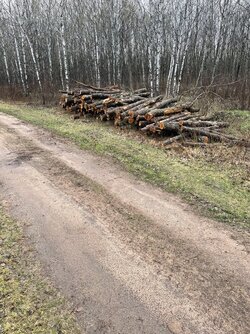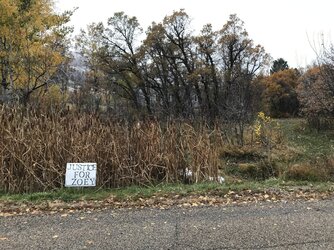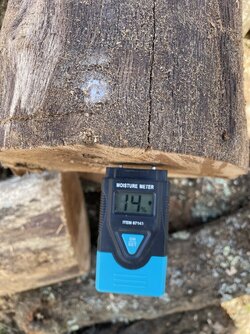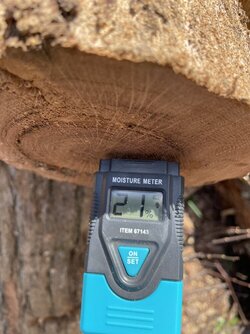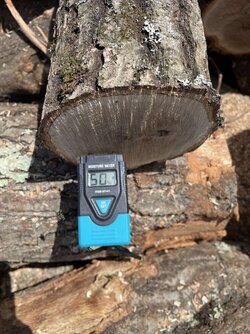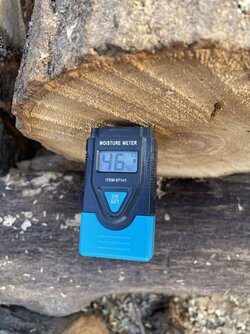Red Oak Score
- Thread starter Todd
- Start date
-
Active since 1995, Hearth.com is THE place on the internet for free information and advice about wood stoves, pellet stoves and other energy saving equipment.
We strive to provide opinions, articles, discussions and history related to Hearth Products and in a more general sense, energy issues.
We promote the EFFICIENT, RESPONSIBLE, CLEAN and SAFE use of all fuels, whether renewable or fossil.
You are using an out of date browser. It may not display this or other websites correctly.
You should upgrade or use an alternative browser.
You should upgrade or use an alternative browser.
Keep us posted on the scrub oak. The scrub oak in my yard in Utah always seems to burn poorly and having a hard time figuring out why? Split stackd outside and seasoned multiple years then inside garage. It's very dry in Utah.Local logger was doing some work about 1/2 mile away so I scored 5 loggers cords of Red Oak from him $100 per cord. He calls it scrub Oak and says it will be ready to burn by this winter! My moisture meter says otherwise, it was pegged out over 60%! Might be ready for 2024/25 season we’ll see.
View attachment 312582
It looks like Northern Red Oak to me. Maybe this Scrub Oak is just a local loggers term? He mentioned that it grows real slow and dense around here because of the sandy well draining soil. It was cut this last winter so he thought it should be dryer than cut in other seasons. Just started bucking it up and ran across some bark less logs that were reading 16-20% but everything that has bark is well over 60%.
Woody Stover
Minister of Fire
You were talking about laying in some Oak at some point, as I recall..Nice get! 👍 Only a half-mile away, that's nice. Or is he bringing it to you?
I still get a jolt of anticipation when I hear wood guys in the distance, and I usually go check it out. 😮
"Scrub Oak" is a nickname, according to the Audubon Guide, mostly applied to southern species. I'd guess that what you indeed have is Red Oak. Some better bark pics, from various diameter wood, should make ID fairly easy. If you had some acorns, that would make ID even easier, but I doubt that's the case.
He wouldn't be the first tree guy with sketchy ID chops.. 😏
Hard to believe that Oak cut a year ago would be that dry, even with the bark off. Who knows how long those mighta been standing dead, though...it's conceivable that it could be that dry. But even Oak I get here with no bark can still be pretty soggy.
I still get a jolt of anticipation when I hear wood guys in the distance, and I usually go check it out. 😮
"Scrub Oak" is a nickname, according to the Audubon Guide, mostly applied to southern species. I'd guess that what you indeed have is Red Oak. Some better bark pics, from various diameter wood, should make ID fairly easy. If you had some acorns, that would make ID even easier, but I doubt that's the case.
He wouldn't be the first tree guy with sketchy ID chops.. 😏
Hard to believe that Oak cut a year ago would be that dry, even with the bark off. Who knows how long those mighta been standing dead, though...it's conceivable that it could be that dry. But even Oak I get here with no bark can still be pretty soggy.
Yeah it’s all Northern Red. I’m a bit surprised they’re no White Oak in there, it grows in the same areas. That bark less stuff had to be dead standing for many years to be that dry.You were talking about laying in some Oak at some point, as I recall..Nice get! 👍 Only a half-mile away, that's nice. Or is he bringing it to you? I still get a jolt of anticipation when I hear wood guys in the distance, and I usually go check it out. 😮 "Scrub Oak" is a nickname, according to the Audubon Guide, mostly applied to southern species. I'd guess that what you indeed have is Red Oak. Some better bark pics, from various diameter wood, should make ID fairly easy. If you had some acorns, that would make ID even easier, but I doubt that's the case. He wouldn't be the first tree guy with sketchy ID chops.. 😏 Hard to believe that Oak cut a year ago would be that dry, even with the bark off. Who knows how long those mighta been standing dead, though...it's conceivable that it could be that dry. But even Oak I get here with no bark can still be pretty soggy.
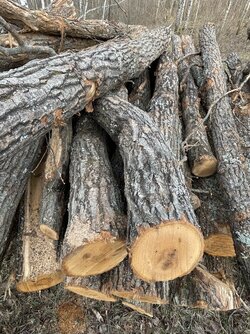
Was under 20 MC after you spilt it? I’m shocked it was that dry.Yeah it’s all Northern Red. I’m a bit surprised they’re no White Oak in there, it grows in the same areas. That bark less stuff had to be dead standing for many years to be that dry.
View attachment 312598
stoveliker
Minister of Fire
Woody Stover
Minister of Fire
Classic Red, with the lighter-colored flats on the bark. Looks slightly different than what I see here, though..Yeah it’s all Northern Red. I’m a bit surprised they’re no White Oak in there, it grows in the same areas. That bark less stuff had to be dead standing for many years to be that dry.
View attachment 312598
I can go out there to a down Red Oak, and where the branches broke when it fell, the remaining part of the branch might be pretty dry for several saw cuts. These are decent-sized branches, maybe 6-8". Maybe a lot of moisture leaves out of the broken end of the branch, not sure..Was under 20 MC after you spilt it? I’m shocked it was that dry.
The Audubon Guide has five Oaks with the nickname "scrub," but only the Mohr Oak has a range anywhere near you in UT.This is what they call scrub oak in my neighborhood in northern Utah. Trees max out at about 20ft tall. Trunks are usually twisty/ bent, and they grow in clusters.
View attachment 312588
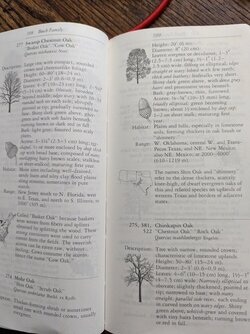
Now, that BL will dry a lot better dead-standing than Oak will..I split some barkless locust (8" dia) a few weeks ago, that likely had been dead up in the tree, and it measured 17 pct
stoveliker
Minister of Fire
Evidently. I have been a bit surprised by that, given the ~10% higher BTU content of BL as compared to red oak.Now, that BL will dry a lot better dead-standing than Oak will..
I used to scrounge a lot of Black Locust at a local recycle area and was surprised how dry and light the rounds were. Most of it was probably dead standing they cut out of a local park.Evidently. I have been a bit surprised by that, given the ~10% higher BTU content of BL as compared to red oak.
johneh
Minister of Fire
I was taught that you split the bucked piece of firewood
and took a moisture reading from the centre of the split
face (across it ) Maybe I have been wrong for the past 50
years! Not saying the way you have done it is wrong
it's just that the reading at the end of a split will be lower
than a reading in the centre of a split
Just my uneducated nickles worth
and took a moisture reading from the centre of the split
face (across it ) Maybe I have been wrong for the past 50
years! Not saying the way you have done it is wrong
it's just that the reading at the end of a split will be lower
than a reading in the centre of a split
Just my uneducated nickles worth
stoveliker
Minister of Fire
I do think measuring with the grain is needed (the intrinsic anisotropy of the material will give different results in different directions). I surmise that measuring across the fibers (as on the cut end of a round), the resistance will be higher, and thus the read-out moisture content lower than when measured with the grain.
But for a log just bucked up, the ends will still be wet, so the need to go "inside" (after splitting) is less. The latter is an issue for rounds that have been laying around (drying, from the outside in) a bit.
But for a log just bucked up, the ends will still be wet, so the need to go "inside" (after splitting) is less. The latter is an issue for rounds that have been laying around (drying, from the outside in) a bit.
Yeah you’re right. I usually take readings from a freshly split piece but these are from 8’ logs freshly bucked, haven’t started splitting yet. Should be pretty similar readings if I split them?I was taught that you split the bucked piece of firewood
and took a moisture reading from the centre of the split
face (across it ) Maybe I have been wrong for the past 50
years! Not saying the way you have done it is wrong
it's just that the reading at the end of a split will be lower
than a reading in the centre of a split
Just my uneducated nickles worth
stoveliker
Minister of Fire
I would expect that splitting would result in pretty similar readings, but slightly higher than this. Not due to the cut end drying but due to the anisotropy.
This also of course depends on the place you measure, as I can see the wood is not very homogeneous (cracks, darker rings etc.)
This also of course depends on the place you measure, as I can see the wood is not very homogeneous (cracks, darker rings etc.)
Here’s the dry Oak round above that read 21% on the end I bucked up yesterday. Now freshly split.
I also split a couple others with the bark and all reading were well over my moisture meter 60% limit. Gave me a OL reading (over limit?) if I just touch the meter pins to the split it will read 35% but as soon as I push the pins into the wood I get OL.
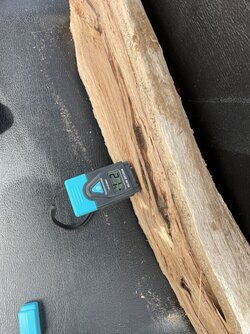
I also split a couple others with the bark and all reading were well over my moisture meter 60% limit. Gave me a OL reading (over limit?) if I just touch the meter pins to the split it will read 35% but as soon as I push the pins into the wood I get OL.

Woody Stover
Minister of Fire
In my experience, it doesn't seem to make much difference, with or across the grain of either end cuts or split faces.Yeah you’re right. I usually take readings from a freshly split piece but these are from 8’ logs freshly bucked, haven’t started splitting yet. Should be pretty similar readings if I split them?
That hasn't been what I've noted here. Wet or dry, that stuff is heavy! Once in a while I run into a short section of BL with the center punking out--those are lighter, as I'd expect.I used to scrounge a lot of Black Locust at a local recycle area and was surprised how dry and light the rounds were. Most of it was probably dead standing they cut out of a local park.
BL will dry a lot better dead-standing than Oak will..
Yep, it's weird because we generally expect wood to dry more slowly, the more dense it is. Red Oak seems to be an exception, and I'm starting to think Black Cherry may be, as well. I had some in the stacks for two summers, medium-small splits, and a couple months ago, it still felt heavy, and gunked up the window. I should go out there right now and split/test a couple of those.Evidently. I have been a bit surprised by that, given the ~10% higher BTU content of BL as compared to red oak.
Might have something to do with the cell structure of the woods, but Red Oak and Cherry seem very different in this regard. I don't know much if anything about wood structure, though..
We find cherry here in NJ is pretty sooty. (NJ jokes accepted)In my experience, it doesn't seem to make much difference, with or across the grain of either end cuts or split faces.
That hasn't been what I've noted here. Wet or dry, that stuff is heavy! Once in a while I run into a short section of BL with the center punking out--those are lighter, as I'd expect.
Yep, it's weird because we generally expect wood to dry more slowly, the more dense it is. Red Oak seems to be an exception, and I'm starting to think Black Cherry may be, as well. I had some in the stacks for two summers, medium-small splits, and a couple months ago, it still felt heavy, and gunked up the window. I should go out there right now and split/test a couple of those.
Might have something to do with the cell structure of the woods, but Red Oak and Cherry seem very different in this regard. I don't know much if anything about wood structure, though..
Gambel Oak
Gambel Oak is the hottest burning firewood species on record in America. It burns at a sweltering 30.7 million BTUs per cord. If you haven’t heard of Gambel Oak before, then that’s probably because it has a fairly limited geographic area where it grows, and is mostly found in Southwest America (e.g. Utah, Arizona, etc.).I had no idea. As i said before, I've had a hard time getting it to burn that great?
stoveliker
Minister of Fire
I don't understand how a large BTU/cord equates to "hotter burning"...
You can load more BTUs into your firebox, but how hot it burns depends on, well how (hot) it burns. It could for example release them very slowly, meaning it won't burn that hot (it'll just burn long).
E.g. pine or fir, with much lower BTU/cord can burn very hot (just less long).
You can load more BTUs into your firebox, but how hot it burns depends on, well how (hot) it burns. It could for example release them very slowly, meaning it won't burn that hot (it'll just burn long).
E.g. pine or fir, with much lower BTU/cord can burn very hot (just less long).
Similar threads
- Replies
- 24
- Views
- 3K


